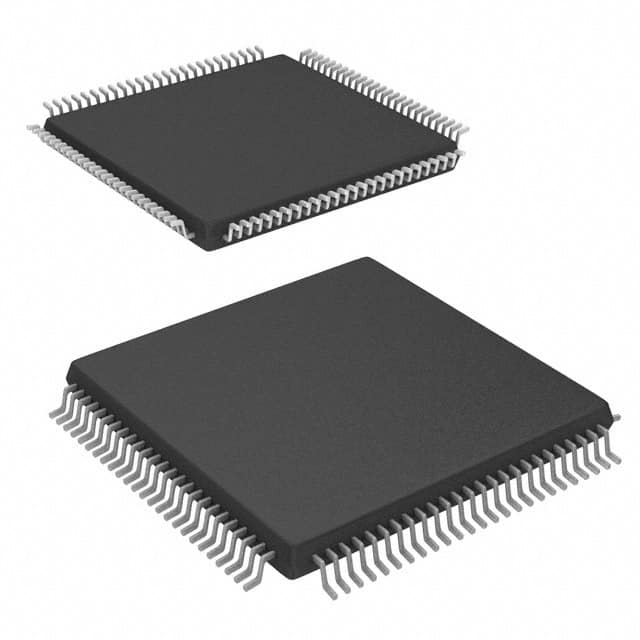EP1K10TC100-3
Product Overview
Category: Integrated Circuit (IC)
Use: The EP1K10TC100-3 is a programmable logic device (PLD) that belongs to the family of Field Programmable Gate Arrays (FPGAs). It is designed for use in various digital applications, including but not limited to, telecommunications, industrial automation, consumer electronics, and automotive systems.
Characteristics: - High-performance FPGA with advanced features - Low power consumption - Flexible and reprogrammable design - Large number of logic elements and I/O pins - Support for various communication protocols - Built-in memory blocks for efficient data storage - On-chip oscillators for clock generation
Package: The EP1K10TC100-3 is available in a compact and durable package, ensuring easy handling and protection against external factors such as moisture and static electricity. The package type is a Thin Quad Flat Pack (TQFP), which allows for efficient heat dissipation.
Essence: This PLD is a key component in digital systems, providing designers with the ability to implement complex logic functions and customize their designs according to specific requirements. Its reprogrammable nature makes it a versatile solution for a wide range of applications.
Packaging/Quantity: The EP1K10TC100-3 is typically sold individually or in reels, depending on the manufacturer's packaging standards. The exact quantity per package may vary, but it is commonly available in quantities suitable for both prototyping and production purposes.
Specifications
- Device Type: Programmable Logic Device (PLD)
- Family: Field Programmable Gate Array (FPGA)
- Model: EP1K10TC100-3
- Technology: 0.18μm CMOS
- Number of Logic Elements: 1,000
- Number of I/O Pins: 100
- Operating Voltage: 3.3V
- Maximum Frequency: 100MHz
- Package Type: Thin Quad Flat Pack (TQFP)
- Temperature Range: -40°C to +85°C
Detailed Pin Configuration
The EP1K10TC100-3 has a total of 100 I/O pins, each serving a specific purpose in the overall functionality of the device. The pin configuration is as follows:
(Pin Number) - (Pin Name) - (Function)
1 - VCCIO0 - Power Supply for Bank 0 I/Os
2 - GND - Ground
3 - IO_0 - User-Defined Input/Output Pin
4 - IO_1 - User-Defined Input/Output Pin
...
99 - IO_98 - User-Defined Input/Output Pin
100 - VCCIO2 - Power Supply for Bank 2 I/Os
Please refer to the datasheet or user manual for a complete pin configuration diagram.
Functional Features
- High-speed data processing capabilities
- Support for various communication protocols such as UART, SPI, and I2C
- On-chip memory blocks for efficient data storage and retrieval
- Flexible I/O configurations for interfacing with external devices
- Built-in clock management resources for precise timing control
- Reconfigurable design allows for easy updates and modifications
- Integrated power-saving features for efficient energy consumption
Advantages and Disadvantages
Advantages: - Versatile and flexible design for customization - High-performance capabilities for demanding applications - Reprogrammable nature allows for iterative development - Wide range of I/O options for interfacing with external devices - Efficient use of power resources for reduced energy consumption
Disadvantages: - Steeper learning curve for inexperienced users - Higher cost compared to fixed-function integrated circuits - Limited availability of alternative models with similar specifications
Working Principles
The EP1K10TC100-3 operates based on the principles of field-programmable gate arrays. It consists of a matrix of configurable logic blocks (CLBs) interconnected through programmable interconnects. These CLBs can be programmed to implement various logic functions, allowing designers to create custom digital circuits.
The device is programmed using Hardware Description Languages (HDLs) such as VHDL or Verilog. The HDL code describes the desired functionality of the circuit, which is then synthesized and mapped onto the FPGA. Once programmed, the EP1K10TC100-3 executes the specified logic functions, enabling the desired behavior in the target application.
Detailed Application Field Plans
The EP1K10TC100-3 finds applications in various fields, including:
- Telecommunications: Used in network routers, switches, and communication equipment for high-speed data processing and protocol handling.
- Industrial Automation: Employed in programmable logic controllers (PLCs) and industrial control systems for real-time monitoring and control of manufacturing processes.
- Consumer Electronics: Integrated into smart devices
قم بإدراج 10 أسئلة وإجابات شائعة تتعلق بتطبيق EP1K10TC100-3 في الحلول التقنية
Sure! Here are 10 common questions and answers related to the application of EP1K10TC100-3 in technical solutions:
Q1: What is EP1K10TC100-3? A1: EP1K10TC100-3 is a specific model of programmable logic device (PLD) manufactured by Intel.
Q2: What are the key features of EP1K10TC100-3? A2: Some key features of EP1K10TC100-3 include 10,000 logic elements, 100 MHz maximum operating frequency, and 3.3V power supply.
Q3: What is the typical application of EP1K10TC100-3? A3: EP1K10TC100-3 is commonly used in various technical solutions that require programmable logic, such as industrial automation, telecommunications, and embedded systems.
Q4: How can EP1K10TC100-3 be programmed? A4: EP1K10TC100-3 can be programmed using hardware description languages (HDLs) like VHDL or Verilog, which allow designers to describe the desired functionality of the PLD.
Q5: Can EP1K10TC100-3 be reprogrammed after it has been programmed once? A5: No, EP1K10TC100-3 is not a reprogrammable device. Once it has been programmed, the configuration remains fixed.
Q6: What are the advantages of using EP1K10TC100-3 in technical solutions? A6: Some advantages of using EP1K10TC100-3 include its high logic capacity, fast operating frequency, and low power consumption.
Q7: Are there any limitations to consider when using EP1K10TC100-3? A7: One limitation is that EP1K10TC100-3 does not support dynamic reconfiguration, meaning the configuration cannot be changed while the device is in operation.
Q8: Can EP1K10TC100-3 interface with other components or devices? A8: Yes, EP1K10TC100-3 can interface with other components or devices through its I/O pins, allowing for communication and integration within a larger system.
Q9: What kind of development tools are available for programming EP1K10TC100-3? A9: Intel provides development tools like Quartus Prime software, which includes a design environment, synthesis tools, and simulation capabilities for programming EP1K10TC100-3.
Q10: Are there any specific design considerations when using EP1K10TC100-3? A10: Some design considerations include power supply requirements, signal integrity, and proper grounding techniques to ensure reliable operation of EP1K10TC100-3 in technical solutions.
Please note that these questions and answers are general and may vary depending on the specific requirements and context of the technical solution.


